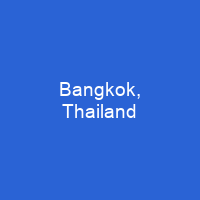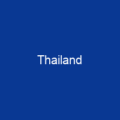Bangkok is the capital and most populous city of Thailand. The city occupies 1,568. 7 square kilometres in the Chao Phraya River delta in central Thailand and has an estimated population of 10. 539 million as of 2020. It has been named the world’s most visited city consistently in several international rankings.
About Bangkok, Thailand in brief
 Bangkok is the capital and most populous city of Thailand. The city occupies 1,568. 7 square kilometres in the Chao Phraya River delta in central Thailand and has an estimated population of 10. 539 million as of 2020. Bangkok traces its roots to a small trading post during the Ayutthaya Kingdom in the 15th century, which eventually grew and became the site of two capital cities: Thonburi in 1768 and Rattanakosin in 1782. As the capital, Bangkok was the centre of Siam’s modernization as it faced pressure from Western powers in the late-19th century. It is an international hub for transport and health care, and has emerged as a centre for the arts, fashion, and entertainment. Bangkok’s rapid growth coupled with little urban planning has resulted in a haphazard cityscape and inadequate infrastructure. The Grand Palace and Buddhist temples including Wat Arun and Wat Pho stand in contrast with other tourist attractions such as the nightlife scenes of Khaosan Road and Patpong. Bangkok faces long-term environmental threats such as land subsidence, which contributes to frequent flooding, an issue expected to be exacerbated by the effects of climate change. It has been named the world’s most visited city consistently in several international rankings, and is known for its street life and cultural landmarks, as well as its red-light districts. Bangkok was subjected to Allied bombing in World War II, but rapidly grew in the post-war period as a result of US military aid and government-sponsored investment.
Bangkok is the capital and most populous city of Thailand. The city occupies 1,568. 7 square kilometres in the Chao Phraya River delta in central Thailand and has an estimated population of 10. 539 million as of 2020. Bangkok traces its roots to a small trading post during the Ayutthaya Kingdom in the 15th century, which eventually grew and became the site of two capital cities: Thonburi in 1768 and Rattanakosin in 1782. As the capital, Bangkok was the centre of Siam’s modernization as it faced pressure from Western powers in the late-19th century. It is an international hub for transport and health care, and has emerged as a centre for the arts, fashion, and entertainment. Bangkok’s rapid growth coupled with little urban planning has resulted in a haphazard cityscape and inadequate infrastructure. The Grand Palace and Buddhist temples including Wat Arun and Wat Pho stand in contrast with other tourist attractions such as the nightlife scenes of Khaosan Road and Patpong. Bangkok faces long-term environmental threats such as land subsidence, which contributes to frequent flooding, an issue expected to be exacerbated by the effects of climate change. It has been named the world’s most visited city consistently in several international rankings, and is known for its street life and cultural landmarks, as well as its red-light districts. Bangkok was subjected to Allied bombing in World War II, but rapidly grew in the post-war period as a result of US military aid and government-sponsored investment.
As Thailand allied with Japan in WWII, Bangkok’s population surged from 1.8million to 3.3million by the end of the war. Bangkok is now a regional force in finance and business, with many multinational corporations locating their regional headquarters in the city. It also plays a key role in Thailand’s politics, economy, education, media and modern society. Bangkok became the stage for power struggles between the military elite and the country’s political elite as the country abolished absolute monarchy in 1932 and adopted constitutional rule, and underwent numerous coups and several uprisings. In the 1990s, the city’s role as a sex tourism destination boosted its tourism industry as it firmly established it as a firmly established tourist destination. It now has a population of over 14 million, making it an extreme primate city, dwarfing Thailand’s other urban centres in both size and importance to the national economy. The City Pillar was erected on 21 April 1782, which is regarded as the date of foundation of the present city. Bangkok initially served as a customs outpost with forts on both sides of the river, and was theSite of a siege in 1688 in which the French were expelled from Siam. After the fall of the Burmese Empire in 1767, the newly crowned King Taksin established his capital at the town, which became the base of the ThonBuri Kingdom. In 1782,. King Phutthayotfa Chulalok moved the capital to the eastern bank’s Rattanageon Island, thus founding the Rattanakeon Kingdom.
You want to know more about Bangkok, Thailand?
This page is based on the article Bangkok, Thailand published in Wikipedia (as of Dec. 30, 2020) and was automatically summarized using artificial intelligence.







